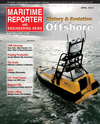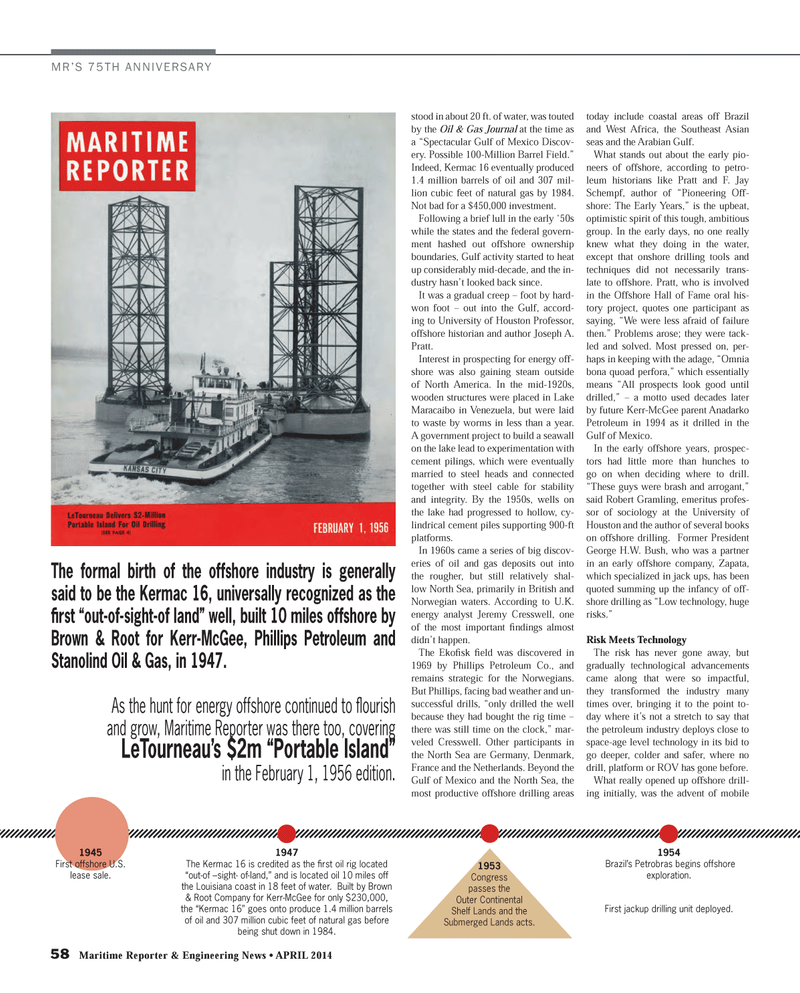
Page 58: of Maritime Reporter Magazine (April 2014)
Offshore Edition
Read this page in Pdf, Flash or Html5 edition of April 2014 Maritime Reporter Magazine
58 Maritime Reporter & Engineering News ? APRIL 2014 MR?S 75TH ANNIVERSARY stood in about 20 ft. of water, was touted by the Oil & Gas Journal at the time as a ?Spectacular Gulf of Mexico Discov-ery. Possible 100-Million Barrel Field.? Indeed, Kermac 16 eventually produced 1.4 million barrels of oil and 307 mil-lion cubic feet of natural gas by 1984. Not bad for a $450,000 investment.Following a brief lull in the early ?50s while the states and the federal govern-ment hashed out offshore ownership boundaries, Gulf activity started to heat up considerably mid-decade, and the in-dustry hasn?t looked back since. It was a gradual creep ? foot by hard-won foot ? out into the Gulf, accord-ing to University of Houston Professor, offshore historian and author Joseph A. Pratt. Interest in prospecting for energy off- shore was also gaining steam outside of North America. In the mid-1920s, wooden structures were placed in Lake Maracaibo in Venezuela, but were laid to waste by worms in less than a year. A government project to build a seawall on the lake lead to experimentation with cement pilings, which were eventually married to steel heads and connected together with steel cable for stability and integrity. By the 1950s, wells on the lake had progressed to hollow, cy- lindrical cement piles supporting 900-ft platforms. In 1960s came a series of big discov-eries of oil and gas deposits out into the rougher, but still relatively shal- low North Sea, primarily in British and Norwegian waters. According to U.K. energy analyst Jeremy Cresswell, one of the most important Þ ndings almost didn?t happen. The EkoÞ sk Þ eld was discovered in 1969 by Phillips Petroleum Co., and remains strategic for the Norwegians. But Phillips, facing bad weather and un-successful drills, ?only drilled the well because they had bought the rig time ? there was still time on the clock,? mar- veled Cresswell. Other participants in the North Sea are Germany, Denmark, France and the Netherlands. Beyond the Gulf of Mexico and the North Sea, the most productive offshore drilling areas today include coastal areas off Brazil and West Africa, the Southeast Asian seas and the Arabian Gulf. What stands out about the early pio-neers of offshore, according to petro- leum historians like Pratt and F. Jay Schempf, author of ?Pioneering Off- shore: The Early Years,? is the upbeat, optimistic spirit of this tough, ambitious group. In the early days, no one really knew what they doing in the water, except that onshore drilling tools and techniques did not necessarily trans-late to offshore. Pratt, who is involved in the Offshore Hall of Fame oral his- tory project, quotes one participant as saying, ?We were less afraid of failure then.? Problems arose; they were tack-led and solved. Most pressed on, per- haps in keeping with the adage, ?Omnia bona quoad perfora,? which essentially means ?All prospects look good until drilled,? ? a motto used decades later by future Kerr-McGee parent Anadarko Petroleum in 1994 as it drilled in the Gulf of Mexico.In the early offshore years, prospec- tors had little more than hunches to go on when deciding where to drill. ?These guys were brash and arrogant,? said Robert Gramling, emeritus profes-sor of sociology at the University of Houston and the author of several books on offshore drilling. Former President George H.W. Bush, who was a partner in an early offshore company, Zapata, which specialized in jack ups, has been quoted summing up the infancy of off- shore drilling as ?Low technology, huge risks.?Risk Meets Technology The risk has never gone away, but gradually technological advancements came along that were so impactful, they transformed the industry many times over, bringing it to the point to- day where it?s not a stretch to say that the petroleum industry deploys close to space-age level technology in its bid to go deeper, colder and safer, where no drill, platform or ROV has gone before. What really opened up offshore drill- ing initially, was the advent of mobile 1953Congress passes the Outer Continental Shelf Lands and the Submerged Lands acts. 1947The Kermac 16 is credited as the Þ rst oil rig located Òout-of Ðsight- of-land,Ó and is located oil 10 miles off the Louisiana coast in 18 feet of water. Built by Brown & Root Company for Kerr-McGee for only $230,000, the ÒKermac 16Ó goes onto produce 1.4 million barrels of oil and 307 million cubic feet of natural gas before being shut down in 1984.1954 BrazilÕs Petrobras begins offshore exploration.First jackup drilling unit deployed.The formal birth of the offshore industry is generally said to be the Kermac 16, universally recognized as the Þ rst Òout-of-sight-of landÓ well, built 10 miles offshore by Brown & Root for Kerr-McGee, Phillips Petroleum and Stanolind Oil & Gas, in 1947. As the hunt for energy offshore continued to ß ourish and grow, Maritime Reporter was there too, covering LeTourneauÕs $2m ÒPortable IslandÓ in the February 1, 1956 edition.1945First offshore U.S. lease sale.MR #4 (56-65).indd 58MR #4 (56-65).indd 584/7/2014 3:13:29 PM4/7/2014 3:13:29 PM

 57
57

 59
59
